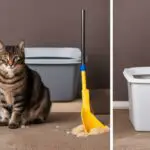Have you ever wondered why your cat puts toys in the litter box? It may seem strange, but this behavior is actually quite common among our feline friends. In this article, I will explore the reasons behind this behavior and provide some insights into what it means for your cat’s behavior and litter box training.
When cats play in the litter box, it’s not necessarily a cause for concern. In fact, it’s a natural behavior that stems from their feral instincts. Playing in the litter box allows cats to engage in activities like jumping, scratching, and digging, which help them exercise and release pent-up energy.
However, if your cat’s play in the litter box becomes excessive, it may indicate an underlying issue. Cats that spend an unusually long time playing in the litter box could be trying to tell you something. It could be a sign of a medical condition such as urinary tract infections, kidney stones, or feline interstitial cystitis. It may also indicate stress, anxiety, or the need to mark territory.
If you notice your cat exhibiting this behavior frequently, it is advisable to consult with a veterinarian. They can help rule out any underlying health issues and provide guidance on how to address the behavior effectively.
Key Takeaways:
- Playing in the litter box is a normal behavior for cats, but excessive play may indicate an underlying issue.
- Medical conditions like urinary tract infections, kidney stones, and feline interstitial cystitis can cause excessive play in the litter box.
- Stress, anxiety, and territorial marking can also lead to increased time spent in the litter box.
- Pregnant cats may seek solace in the litter box as they near their due date.
- Boredom and lack of stimulation may drive cats to play in the litter box.
Medical Conditions that Cause Playing in the Litter Box
Several medical conditions can lead to excessive playing in the litter box in cats. It is important to be aware of these conditions and seek veterinary attention if necessary. Some of the common medical issues that can cause this behavior include:
- Urinary Tract Infections: Cats with urinary tract infections may spend more time in the litter box because they experience discomfort or pain while urinating. This can lead to prolonged stays in the litter box as they try to relieve themselves. If your cat is exhibiting this behavior, it is important to consult a vet for proper diagnosis and treatment.
- Kidney Stones: Cats with kidney stones may also exhibit excessive litter box play. The discomfort and itching caused by the stones can lead to increased scratching and rolling in the litter. It is crucial to address this issue promptly to prevent further complications.
- Feline Interstitial Cystitis: Feline interstitial cystitis is a condition that causes inflammation of the bladder, resulting in urinary tract symptoms. Cats with this condition may spend more time in the litter box due to the discomfort they experience. Veterinary intervention is necessary to manage this condition and provide relief for the cat.
| Medical Condition | Symptoms | Treatment |
|---|---|---|
| Urinary Tract Infections | Difficulty urinating, frequent urination, blood in urine, excessive time in the litter box. | Antibiotics, pain management, dietary changes. |
| Kidney Stones | Discomfort, itching, increased time spent in the litter box, blood in urine. | Fluid therapy, prescription diet, surgical removal if necessary. |
| Feline Interstitial Cystitis | Frequency and urgency of urination, discomfort, excessive time in the litter box. | Pain medication, stress reduction techniques, environmental enrichment. |
If your cat is displaying excessive play in the litter box, it is essential to consider these medical conditions as potential causes. Consulting a veterinarian will allow for proper diagnosis and the implementation of appropriate treatment plans. By addressing these underlying health issues, you can help improve your cat’s overall well-being and reduce litter box-related behaviors.
Stress and Anxiety as a Cause of Litter Box Play
When cats display excessive play behavior in the litter box, it may be a sign of stress or anxiety. This behavior is often seen in cats that are in a new environment or experiencing changes in their surroundings. Cats use the litter box as a safe and familiar space where they can find comfort and security during times of stress.
To help reduce stress and anxiety in cats, it is important to create a calm and reassuring environment. This can be achieved by providing a quiet and secluded area for the litter box, away from noisy and high-traffic areas. Additionally, offering plenty of hiding spots and elevated perches can help cats feel more secure in their surroundings.
Introducing environmental enrichment techniques, such as interactive toys, puzzle feeders, and scratching posts, can also offer mental and physical stimulation, helping to alleviate stress and anxiety. It is important to note that these techniques may take time to have an effect, and patience is key in helping cats adapt to new environments and overcome anxiety.
Managing Stress and Anxiety in Cats:
- Create a calm and reassuring environment
- Provide a quiet and secluded area for the litter box
- Offer hiding spots and elevated perches
- Introduce environmental enrichment techniques
- Be patient and allow time for adaptation
“Creating a safe and stress-free environment for your cat can go a long way in addressing litter box play caused by anxiety.”
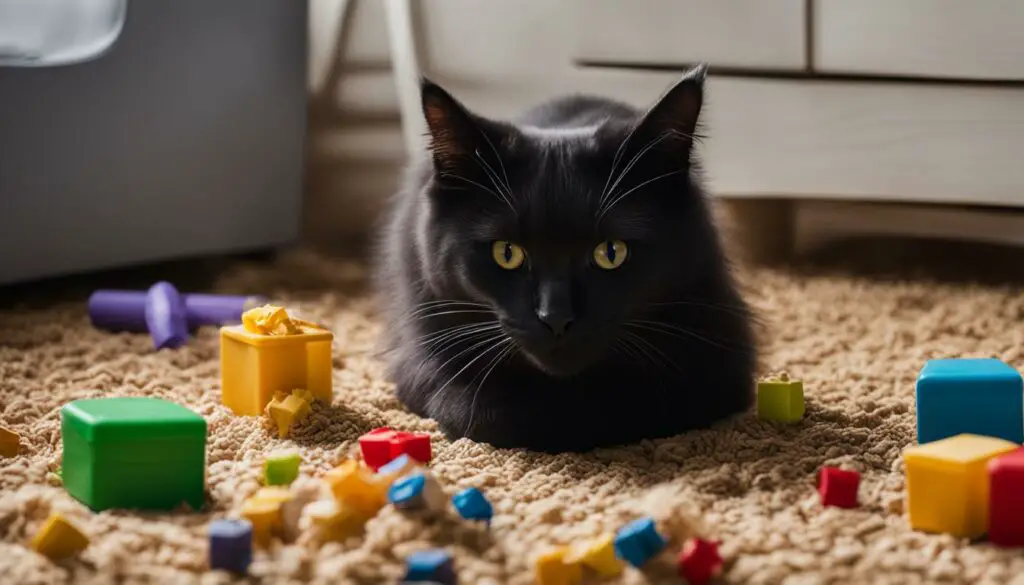
By addressing stress and anxiety in cats, pet owners can help alleviate litter box play behavior and promote a harmonious living space for their furry companions. However, if the behavior persists or worsens despite these management techniques, it is recommended to consult a veterinarian or a cat behavioral specialist for further guidance and support.
Territory Marking and Unfamiliar Litter Boxes
When it comes to cats and their litter boxes, territory marking can play a significant role in their behavior. Cats have a natural instinct to mark their territory, and one way they do this is by spending time in the litter box. This behavior is especially common when introducing a new or unfamiliar litter box to multiple cats in a household.
By playing in the litter box, cats are claiming ownership and establishing their scent. It’s their way of saying, “This is mine, and I’m leaving my mark here.” While this behavior can be frustrating for cat owners, it is a normal part of feline behavior and should be understood and managed appropriately.
To address territory marking in multiple cat households, it is recommended to provide each cat with their own litter box. This allows each cat to have their personal space and reduces the need for one cat to mark over another’s scent. Additionally, ensuring that each litter box is placed in a separate, quiet area can help minimize any potential territorial conflicts.
| Benefits of Providing Multiple Litter Boxes | Tips for Reducing Territory Marking |
|---|---|
|
|
By providing multiple litter boxes and creating an environment where each cat feels secure and comfortable, you can help alleviate territory marking behavior and promote harmony among your feline companions.
Pregnancy and Litter Box Behavior
Pregnant cats may exhibit unique behavior related to their litter box during the gestation period and especially as they approach their due date. It is important for cat owners to understand and provide appropriate support for their pregnant feline companions during this time.
During pregnancy, the litter box can provide a sense of privacy and security for a pregnant cat. The nesting instinct may prompt them to spend more time in the litter box as they prepare for giving birth. They may choose to stay in the litter box during labor as it provides a secluded and familiar environment for them to deliver their kittens.
When preparing for the arrival of kittens, it is crucial to create a comfortable and quiet space for the pregnant cat. This can include providing a separate area with a cozy bed, ensuring easy access to food and water nearby, and placing the litter box in a tranquil location. By doing so, cat owners can help reduce stress and provide a safe environment for the mother and her newborns.
If there are any concerns or complications during the birthing process, it is recommended to contact a veterinarian. They can provide guidance and support to ensure a smooth delivery and the well-being of both the mother and her kittens.
Table: Signs of Labor in a Pregnant Cat
| Signs of Labor | Description |
|---|---|
| Restlessness | The cat may appear agitated, pacing, or unable to settle. |
| Nesting behavior | The cat may search for a suitable birthing spot and arrange bedding. |
| Increased vocalization | The cat may meow more frequently or be more vocal than usual. |
| Mucus discharge | Clear or slightly bloody discharge from the vulva may be observed. |
| Contractions | The cat may exhibit abdominal contractions, visible by abdominal movement. |
| Breaking of water | The cat’s water sac may rupture, leading to the start of labor. |
Understanding and addressing the unique litter box behavior of a pregnant cat can help ensure a smooth and stress-free experience for both the mother and her kittens.
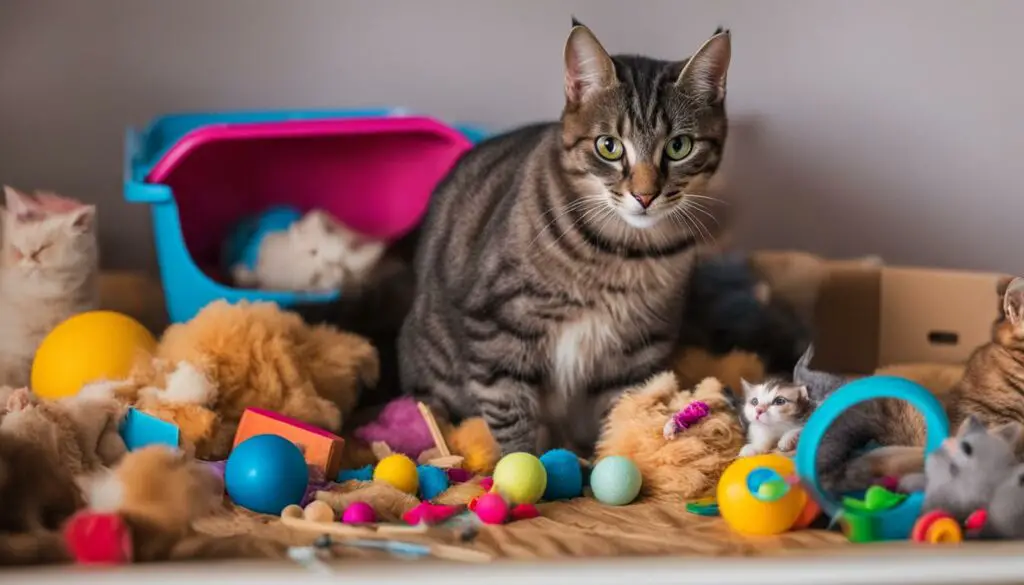
Boredom and Lack of Stimulation
Cats are naturally curious and active creatures, and they need mental and physical stimulation to thrive. When they don’t have enough outlets for play and entertainment, they may resort to finding their own sources of amusement, such as playing in the litter box. This behavior can be a sign of boredom and a lack of stimulation.
One way to address this issue is by providing a variety of toys and interactive play sessions. Cats enjoy toys that simulate hunting, like feather wands or laser pointers. Puzzle toys that dispense treats can also keep them mentally engaged. Additionally, setting aside dedicated playtime each day can help prevent boredom and reduce the likelihood of litter box play.
Environmental enrichment is also crucial to keep cats mentally stimulated. Providing scratching posts, climbing trees, and hiding spots can offer them a range of activities to explore. Additionally, rotating toys and introducing new ones periodically can help keep their interest piqued. By offering a stimulating environment, you can help alleviate boredom and discourage litter box play.

Benefits of Environmental Enrichment for Cats
Environmental enrichment plays a vital role in a cat’s overall well-being. It helps prevent behavioral issues, such as excessive scratching, aggression, and litter box problems. By providing cats with a range of activities and opportunities to engage their natural instincts, you can help promote their physical and mental health.
Enriching a cat’s environment can also alleviate stress and anxiety, which are common reasons for litter box play. By creating a calm and stimulating environment, cats are less likely to engage in unwanted behaviors, including excessive time spent in the litter box.
Remember, each cat is unique, and it may take some trial and error to find the right combination of toys and activities that engage and entertain them. By addressing boredom and providing adequate stimulation, you can create a happy and fulfilled feline companion.
Dust Bathing and Itching
Some cats have a natural instinct to engage in dust bathing behavior, which involves rolling in the litter box. This behavior may seem odd to cat owners, but it serves a purpose for the cat. Dust bathing can provide relief from itching and help remove excess fur and bacteria from their coat. It is a self-grooming mechanism that helps them maintain cleanliness and hygiene. While this behavior may be annoying for cat owners who have to clean the litter box more frequently, it is important to understand that it is a natural instinct for the cat.
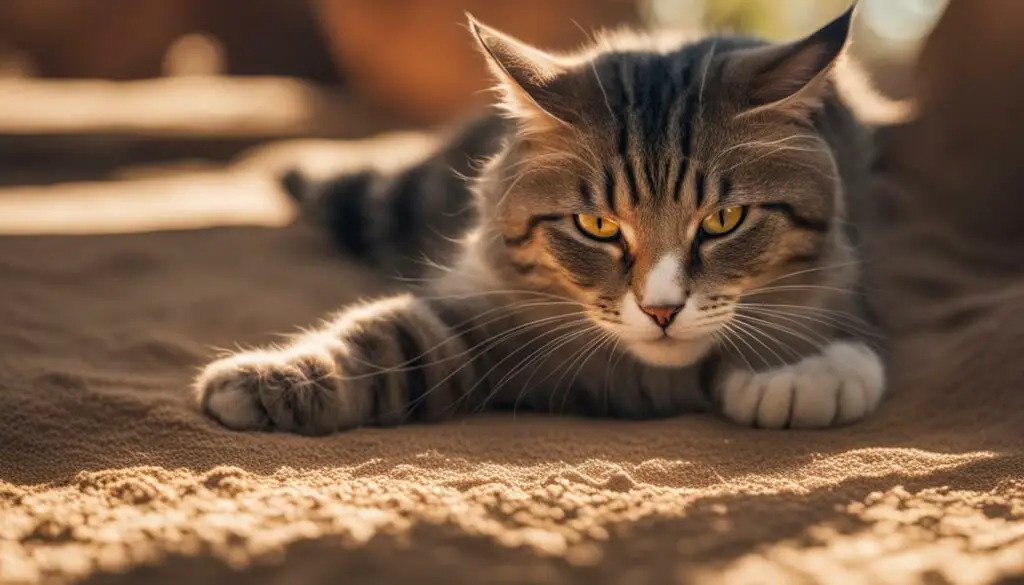
Regular grooming can help minimize the need for dust bathing. Brushing your cat’s fur regularly can remove loose hair and prevent excessive shedding. Providing appropriate scratching surfaces like scratching posts can also help alleviate itching and reduce the need for dust bathing. Additionally, ensuring a clean and hygienic litter box environment can reduce the build-up of bacteria and dirt, further minimizing the need for dust bathing.
It is important to note that excessive itching and scratching can be a sign of an underlying issue, such as allergies or parasites. If your cat is constantly itching, has irritated skin, or shows signs of discomfort, it is recommended to consult with a veterinarian for a proper diagnosis and treatment.
Instinct to Bury Wastes
Cats have a natural instinct to bury their waste, which is rooted in their feline ancestry. This behavior serves multiple purposes, including masking the scent of their presence from potential predators and maintaining cleanliness in their environment. Even in a litter box where actual burying is not possible, cats may still exhibit the instinct to bury fresh litter or hide their feces when there is already fresh litter present.
This instinctual behavior is seen as a way for cats to maintain their territory and mark their presence. By covering their waste, they are essentially hiding any evidence of their presence and protecting their territory from potential threats. This behavior is completely normal and does not indicate any underlying issues.
In the wild, cats would typically bury their waste in soft soil or sand. The litter box serves as a suitable substitute for this natural behavior in a domestic setting. While some cats may exhibit more vigorous burying behaviors than others, the instinct to cover their waste is ingrained in all cats to some degree.
| Benefits of Burying Instinct | Explanation |
|---|---|
| Masking presence | By burying their waste, cats can hide the scent of their presence from potential predators. |
| Territory marking | Burying waste helps cats establish and maintain their territory, keeping other cats at bay. |
| Maintaining cleanliness | Covering waste serves to keep the environment clean and free of unpleasant odors. |
It’s important to provide your cat with a clean litter box and ensure that it is changed regularly. This will help maintain a hygienic environment and prevent any potential health issues. Additionally, it’s recommended to have one litter box per cat in the household, as this allows each cat to have their own space and reduces the chances of litter box-related stress.
Understanding and respecting your cat’s instinct to bury their waste will help you create a harmonious living space for both you and your feline companion. By providing a suitable litter box and maintaining cleanliness, you can ensure that your cat feels comfortable and secure in their environment.
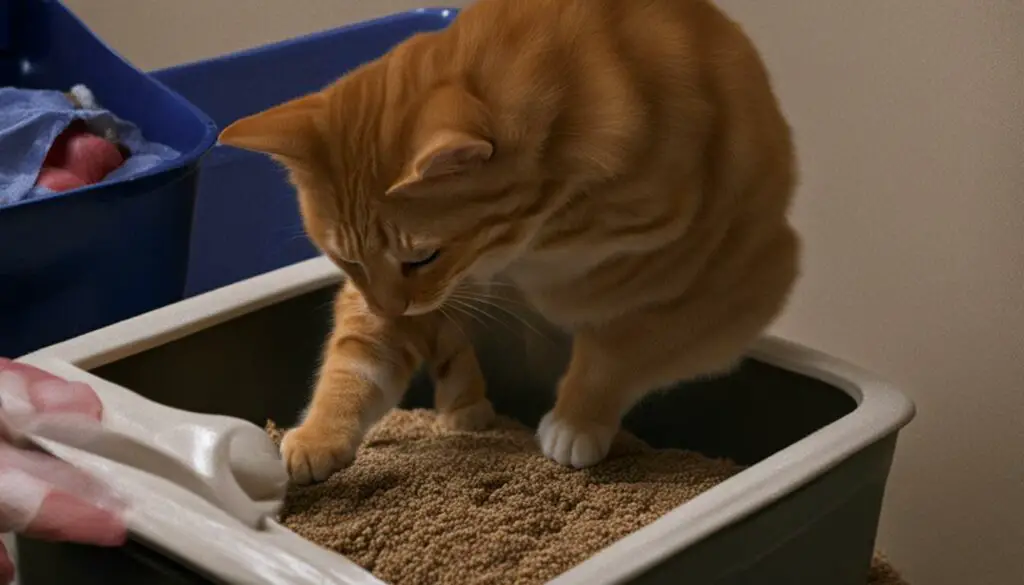
Managing Litter Box Play
When it comes to managing litter box play, there are a few key strategies that can help cat owners create a harmonious and hygienic living space. One important aspect is providing multiple litter boxes in different locations. Cats are territorial animals, and having their own designated space can reduce competition and prevent litter box problems. Aim for one litter box per cat, plus an extra one, to ensure everyone has access to a clean and comfortable area.
Keeping the litter box clean is also crucial in managing litter box play. Cats are naturally clean animals and prefer a tidy restroom. Regularly scoop out waste and replace soiled litter to maintain a pleasant environment. Ideally, the litter box should be cleaned after each use to prevent the spread of urinary tract infections and promote good hygiene.

For some cats, the design and material of the litter box can make a difference. Covered litter boxes can provide privacy and help contain odors. Some cats may prefer an open design that allows them to easily enter and exit the litter box. Experimenting with different options can help you find the best fit for your feline companion.
Overall, managing litter box play involves creating a comfortable and inviting environment. By providing multiple litter boxes, keeping them clean, and considering different designs, you can help prevent litter box problems and ensure a happy and healthy cat.
Addressing Stress and Anxiety
Stress and anxiety can have a significant impact on a cat’s behavior, including spending excessive time in the litter box. As a cat owner, it’s important to address these underlying issues to help your feline companion feel calm and secure. In some cases, consulting a cat behavioral specialist can provide valuable insights and guidance in managing stress and anxiety.
When addressing stress and anxiety in cats, it’s essential to create a calm and secure environment. Provide your cat with a designated space where they can retreat and feel safe, away from noise and disturbances. This can be a cozy corner with a comfortable bed or a secluded area in your home.
Establishing routines and providing plenty of mental and physical stimulation is also crucial in reducing stress and anxiety. Cats thrive on predictability, so try to maintain a consistent daily routine. Engage in interactive play sessions to stimulate their natural instincts and provide environmental enrichment, such as puzzle toys or scratching posts.
If your cat’s stress and anxiety persist despite your efforts, consulting a cat behavioral specialist can offer expert guidance tailored to your cat’s specific needs. They can help identify the root causes of the anxiety and develop a personalized behavior modification plan. With professional support, you can work towards creating a harmonious and stress-free environment for your cat.
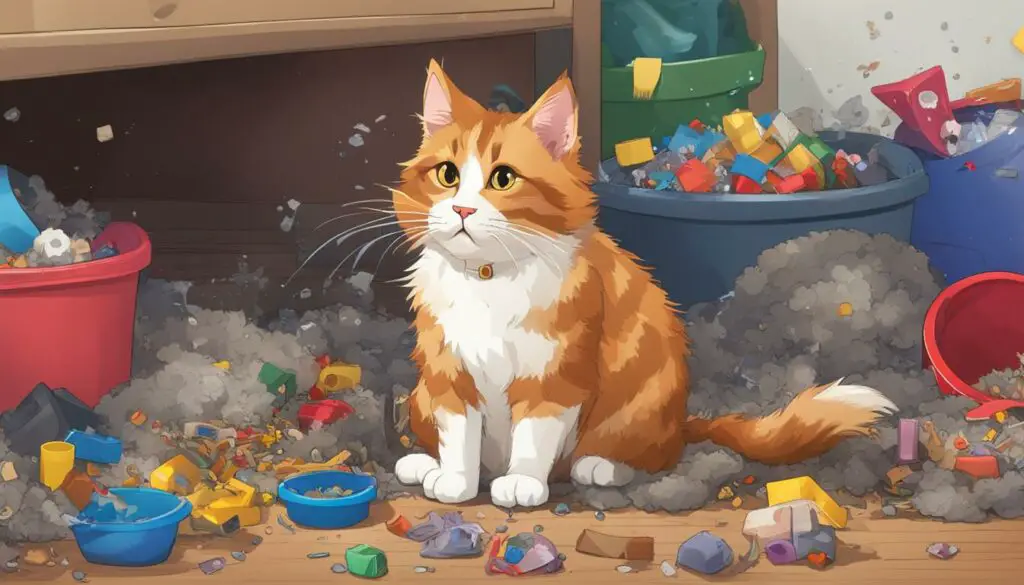
Expert Quote:
“Addressing stress and anxiety in cats requires a multifaceted approach. It’s important to create a safe and calm environment, establish routines, and provide mental and physical stimulation. If the behavior persists, consulting a cat behavioral specialist can provide valuable insights and guidance.
Choosing the Right Location for the Litter Box
When it comes to the location of your cat’s litter box, it’s important to consider their comfort and privacy. Placing the litter box in a quiet area of your home can help create a calm environment that encourages proper litter box use. Avoid placing it in high-traffic areas or near loud noises, as these can be distracting and may make your cat feel uncomfortable.
Creating a designated space for the litter box can also help your cat feel secure. Choose a corner or a less frequented area of your home where they can have some privacy while using the litter box. This can help reduce any potential stress or anxiety associated with toileting.
Additionally, make sure the litter box is easily accessible for your cat. If you have multiple levels in your home, consider having a litter box on each floor to make it convenient for your cat to find a suitable spot when nature calls.
To summarize, when choosing the right location for your cat’s litter box, aim for a quiet place that offers privacy and is easily accessible. By providing a comfortable and inviting litter box environment, you can help ensure your cat feels secure and confident while taking care of their toileting needs.

| Benefits of Choosing the Right Location for the Litter Box |
|---|
| 1. Reduces distractions and noise |
| 2. Provides privacy and security |
| 3. Encourages proper litter box use |
| 4. Minimizes stress and anxiety |
| 5. Makes it convenient for your cat to access |
Creating an Odor-Free Litter Box
As a cat owner, ensuring that your home remains odor-free is essential for maintaining a pleasant living environment. One area that can sometimes become a source of unpleasant smells is the litter box. Fortunately, there are several steps you can take to create an odor-free litter box for your feline companion.
A covered litter box can be an effective solution for containing odors. The cover helps to trap and filter out unpleasant smells, preventing them from spreading throughout the room. When choosing a covered litter box, look for one that has a built-in carbon filter. This will help to further neutralize odors and keep your home smelling fresh. Additionally, a covered litter box provides your cat with a sense of privacy while they do their business, promoting a calm and stress-free environment.
Regular cleaning is essential for maintaining an odor-free litter box. Make it a habit to clean the litter box at least once a day, removing any clumps and solid waste. If you notice any strong odors, consider changing the litter more frequently. It’s also important to fully replace the litter and clean the litter box at least once a week. This will help prevent the buildup of bacteria and eliminate any lingering odors.
Investing in odor-control litter can also make a significant difference in managing litter box smells. There are various types of litter available that are specifically designed to control odors, such as those containing activated charcoal or baking soda. These ingredients help to absorb and neutralize odors, keeping the litter box fresh for longer periods of time.
“A covered litter box can be an effective solution for containing odors.”
| Litter Box Cleaning Tips | Frequency |
|---|---|
| Remove clumps and solid waste | Once a day |
| Replace litter and clean litter box | Once a week |
| Consider changing litter more frequently if strong odors persist | – |
In addition to these steps, it’s important to ensure proper ventilation in the area where the litter box is located. Good airflow will help prevent the buildup of odors and ensure a fresh-smelling space. If possible, place the litter box in a well-ventilated area or near a window.
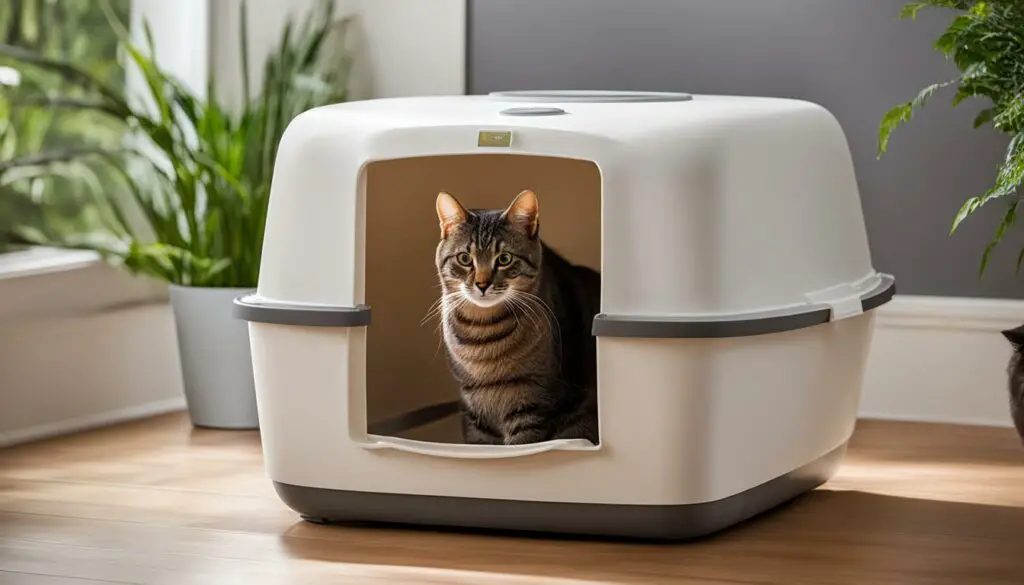
By implementing these measures, you can create an odor-free litter box that both you and your cat will appreciate. A clean and fresh-smelling litter box not only contributes to a pleasant living environment but also promotes your cat’s overall wellbeing and hygiene.
Conclusion
Cats playing in the litter box can be a normal behavior that stems from their feral instincts, boredom, or the need for stimulation. It is a natural way for them to exercise and engage in activities like jumping, scratching, and digging. However, excessive play in the litter box may indicate underlying medical issues or stress and anxiety.
If your cat spends an excessive amount of time in the litter box, it is important to address any concerns and consult a veterinarian. Medical conditions such as urinary tract infections, kidney stones, and feline interstitial cystitis can cause discomfort and lead to excessive time in the litter box. Stress and anxiety, especially in a new environment, can also contribute to this behavior.
To create a harmonious and hygienic living space for your feline companion, it is essential to manage the litter box environment. Providing multiple litter boxes in different locations, keeping them clean, and ensuring regular changes of litter can help prevent urinary tract infections. Additionally, addressing stress and anxiety through a calm and secure environment, appropriate enrichment, and consultation with a cat behavioral specialist if necessary, can alleviate litter box play caused by these factors.
By understanding and addressing the reasons behind your cat’s litter box play, you can ensure their overall well-being and create a comfortable environment for both you and your feline companion.
FAQ
Why does my cat play in the litter box?
Playing in the litter box is a normal behavior for cats. It allows them to exercise their feral instincts and engage in activities like jumping, scratching, and digging.
When does playing in the litter box become excessive?
Excessive play in the litter box may indicate underlying issues such as medical conditions or stress and anxiety. If the behavior persists or becomes disruptive, it is recommended to consult a vet.
What medical conditions can cause excessive time in the litter box?
Cats spending excessive time in the litter box may be a sign of urinary tract infections, kidney stones, or feline interstitial cystitis. Seeking veterinary attention is crucial for proper diagnosis and treatment.
How can stress and anxiety contribute to litter box play?
Cats may play in the litter box when they are stressed or anxious, especially in a new environment. Creating a calm and reassuring environment, providing enrichment, and establishing routines can help reduce stress.
Why do cats play in the litter box to mark territory?
Cats may play in the litter box to mark their territory, especially when introduced to a new or unfamiliar litter box. Providing multiple litter boxes and ensuring each cat has its own space can help alleviate this behavior.
Why does my pregnant cat spend time in the litter box?
Pregnant cats may seek solace in the litter box, especially as they near their due date. The litter box provides a sense of privacy and safety for them during labor. Ensure a comfortable and quiet birthing space for your cat.
Can boredom lead to litter box play?
Yes, cats may engage in litter box play out of boredom or a lack of stimulation. Providing a variety of toys, interactive play sessions, and environmental enrichment can help alleviate boredom.
Why do some cats engage in dust bathing in the litter box?
Cats may roll in the litter box as a form of dust bathing, which can provide relief from itching and remove excess fur and bacteria. Regular grooming and appropriate scratching surfaces can help address this behavior.
Why do cats have an instinct to bury their waste?
Cats have a natural instinct to bury their waste to mask their presence from potential predators. This behavior is normal even in litter boxes where burying is not possible.
How can I manage excessive litter box play?
Providing multiple litter boxes in different locations, keeping the litter box clean, and ensuring regular litter changes can help prevent urinary tract infections and maintain a pleasant environment for your cats.
How can I address stress and anxiety that leads to litter box play?
To address stress and anxiety, create a calm and secure environment, establish routines, and offer mental and physical stimulation. In severe cases, consulting a cat behavioral specialist may be beneficial.
Where should I place the litter box to encourage appropriate use?
Placing the litter box in a quiet area with no loud noises or distractions can create a calm and inviting environment for your cat. Avoid placing it near play areas or high-traffic areas.
How can I create an odor-free litter box?
Consider using a covered litter box to contain smells. Regularly clean the litter box, ideally after each use, and use odor-control litter or self-cleaning litter box options to keep the house smelling fresh.
What can I conclude about cats playing in the litter box?
Cats playing in the litter box can be a normal behavior stemming from feral instincts, boredom, or the need for stimulation. However, excessive play may indicate medical issues or underlying stress and anxiety. By managing the litter box environment, providing appropriate enrichment, and addressing any underlying issues, you can create a harmonious and hygienic living space for your cat.





